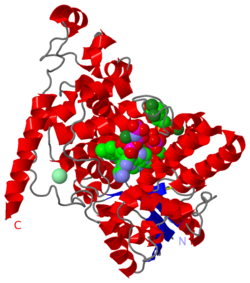Extraordinary Proteins. Extreme lifestyles sometimes require sensing the earth's magnetic field. Trytophan and aspartic acid residues may be key to an organism's ability to pick up where it is relative to Earth's magnetic poles.
Birds, turtles, butterflies and other animals migrate with the help of the compasses built into their bodies. Drs. Schulten and Solov'yov described a mechanism taking place within the birds' retina tissue, inside the rod cells, inside cryptochrome proteins known to process blue light for entraining circadian cycles, but now perhaps also deserving to be known as the seat of these organism's ability to sense magnetic fields[1].
Molecular Tour:
The absorbs a single photon of blue light of 2.7 eV, exciting either of the FAD ligand's two nitrogen atoms, which are involved in resonance (and shown in halos, as are the ). This FAD nitrogen atom is protonated by a nearby aspartic amino acid (the proximate donors shown with halos), and the electron hole is filled through a series of electron transfers from the three tryptophan amino acids (the nitrogen donors shown with halos). Notably, as seen in this alternative view, FAD and the three tryptophans from the protein's inside to its outside. At this stage, where FAD is in its active signaling state, the extra electron on FAD and lone electron on the final tryptophan amino acid (324) (location of the electrons shown with halos). The pair is entangled, but only when they spin in the opposite directions, can the extra electron on FAD return and fill the hole left in tryptophan 324.
Researchers Klaus Schulten at University Illinois at Urbana Champaign and Ilya Solov'yov, now at the University of Southern Denmark, connect this system to the fascinating ability of many birds, and other flying species, to migrate while sensing the earth's magnetic field. Through simulations, they show that where the bird's cryptochrome compass's (shown as a dotted line) is aligned with the line extending between the earth's poles, the entangled electrons will 'on average' spend more time spinning in the same direction, and therefore by delaying the electrons return to trp324, FAD will 'on average' be in its signalling mode for longer.
Therefore, as a possible explanation, because many cryptochrome proteins are involved in registering blue light photons - millions of proteins per cell, and many cells across the retina, a change in the average time spent in the signalling state - "the transition rate" - is perhaps measured by the brain as the time until 50% of the cells do not have active FAD molecules. By moving its head about in different directions, a bird can find position at which the signalling last longest. That places the bird along the world's north-south pole axis.

